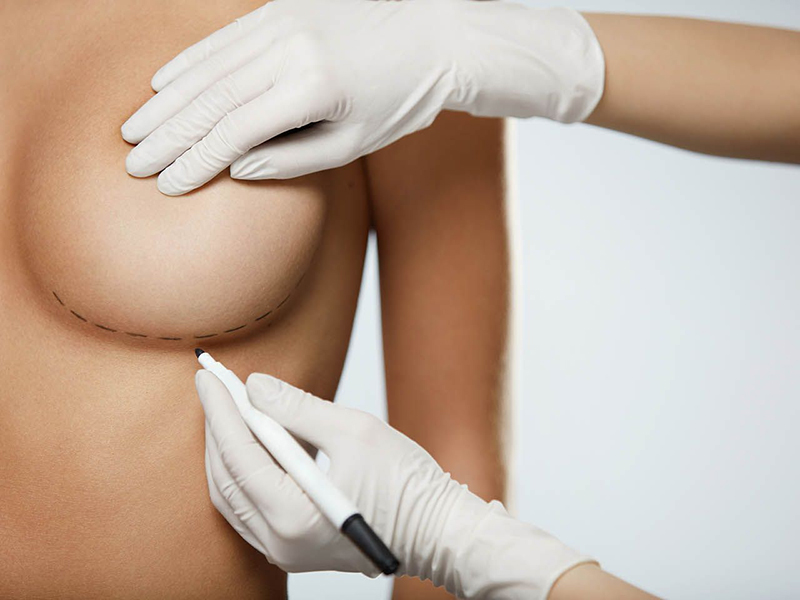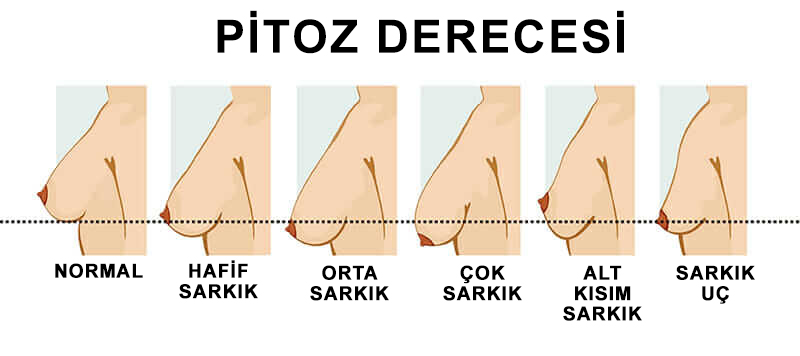
Breast Lift Surgery
Patients who wish to undergo a breast lift surgery often expect the flattening and sagging of their breasts to be corrected, along with the creation of a beautiful and attractive cleavage. When these goals are achieved post-surgery, patients are generally very satisfied with the appearance of their breasts. But what about the scars? Scars typically take the form of a racket-shaped line that runs vertically from the areola to the lower breast crease or an inverted T-shape extending along the breast fold. These scars are usually hidden along the natural anatomical contours of the breast and become nearly invisible after one year of proper healing. ALMOST INVISIBLE!!
Patients who undergo breast lift surgery experience a noticeable boost in self-confidence, both in their daily lives and private lives.

Does the numerical size of your bra change after a breast lift?
The numerical size of your bra (e.g., 75, 80, 90, 95, etc.) represents the circumference of your chest and remains unchanged after a breast lift. However, the cup size (A, B, C, etc.), which corresponds to breast volume, will change and is intended to change. The typical target cup size for breast lift surgery is a B cup. Wearing a B cup bra indicates that the sagging of the breasts has been corrected, restoring them to their ideal size.
The appearance of the cleavage area will change after the surgery. However, raising the upper boundary of the breasts cannot be achieved with a lift alone. If it is desired to raise this line by 2 cm or more, fat injection or breast implants must be combined with the breast lift surgery. Similarly, to achieve significant changes in the gap between the breasts or to make them closer together, fat injections to this area are necessary.
Pre-Surgery Preparations
If you've decided to undergo a breast lift, it is essential to reach your ideal weight before the surgery. Performing the procedure at an appropriate weight improves aesthetic results significantly and may also minimize the length of scars. Additionally, smoking must be stopped. It is recommended to quit smoking at least 4 weeks before surgery and refrain from smoking for at least 4 weeks after the operation. Patients who have lost weight and quit smoking are considered ideal candidates for a breast lift surgery.
Frequently Asked Questions
1. Does breast lift surgery require general anesthesia or hospitalization?
Yes, a breast lift is performed under general anesthesia in a hospital setting. A minimum hospital stay of 6 hours or an overnight stay is required.
2. How long does breast lift surgery take?
The average duration of breast lift surgery is approximately 3 hours.
3. Will scars form after a breast lift surgery?
Yes, scars will form in the shape of an inverted T or a lollipop. Over time, these scars fade into thin lines.
4. When do the scars become less visible?
The scars are most visible during the first two months, appearing red and slightly raised. They gradually fade into fine lines, usually within one year.
5. What are the benefits of a breast lift?
A breast lift enhances the aesthetic shape of the breasts and eliminates skin irritation or rashes that often develop under sagging breasts.
6. Am I an ideal candidate for a breast lift?
The ideal candidate for a breast lift is someone who has achieved a stable and appropriate body weight.
7. Is a mammogram necessary before a breast lift?
All patients over 40 years old should undergo breast screenings, ultrasounds, and mammograms before breast surgery.
8. What are the types of breast lift surgery?
Depending on the degree of sagging, a breast lift can be performed using either an inverted T incision or a lollipop incision.
9. Can I breastfeed after a breast lift?
Yes, breastfeeding is possible after a breast lift surgery.
10. What is the recovery time after a breast lift?
The recovery period is approximately 2 weeks. A special bra must be worn for at least 6 weeks.
11. What are the risks of breast lift surgery?
Risks include delayed wound healing and wound separation. For smokers, the most significant risk is impaired circulation to the nipple. Smoking should be stopped at least 4 weeks before the surgery.
12. How long do the results of a breast lift last?
Results vary depending on the individual but will never return to the pre-surgery state.
13. What should I avoid before the surgery?
Smoking must be stopped, and excessive consumption of green tea, dietary supplements, or vitamins that thin the blood should be avoided.
14. What should I do after the surgery?
Avoid smoking and heavy lifting during the first week. Wear the recommended surgical bra for 6 weeks.
15. Will there be pain after the surgery?
While pain levels vary depending on individual tolerance, the surgery is not highly painful. Pain, if present, is most pronounced during the first week and can be managed with painkillers.
16. Will there be bruising after the surgery?
Yes, there may be bruising around the incision sites.
17. Will there be wounds after the surgery?
Small, pimple-like wounds may form around the incision areas due to suture reactions.
18. Will there be loss of sensation after the surgery?
Generally, sensation loss is uncommon. If it occurs, it typically resolves within 6 months.
19. Will there be asymmetry after the surgery? If so, will another surgery be necessary?
Symmetry is usually achieved, but in cases with significant asymmetry before the surgery, slight asymmetry may persist. If asymmetry remains, a revision surgery can be performed after 6 months.
20. Will scars form after the surgery? When will they fade?
Scars are permanent but usually fade into thin, barely noticeable lines within a year.